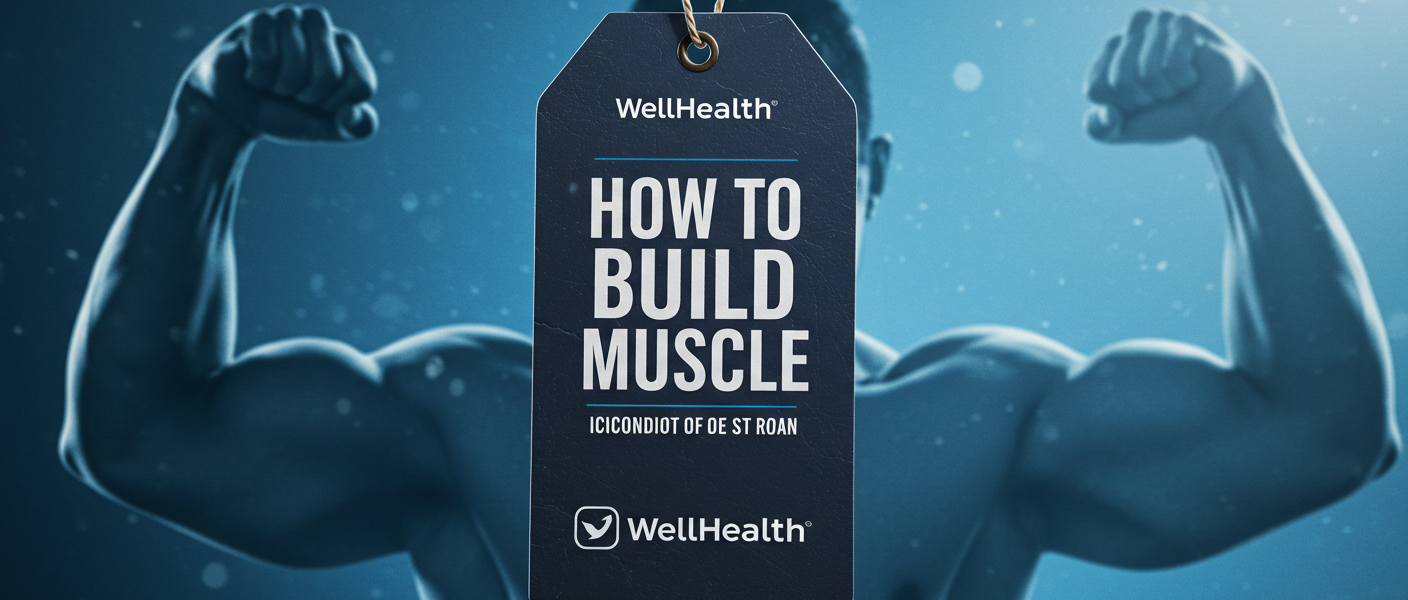There is more to building muscle than simply lifting heavy things — there is consistency, balance, evidence-based methods that include diet, exercise, recovery, and mindset. The “WellHealth how to build muscle tag” is a natural and sustainable approach for building lean muscle mass for all fitness levels. Everything from the science behind muscle hypertrophy to training protocols, nutrition, common mistakes to avoid and more are covered in this guide.
Understanding Muscle Growth
When you work out, your muscle fibers are placed under tension through resistance training, and muscle hypertrophy, or muscle growth, results. This involves the catabolism of muscle, followed by its repair and adaptation, over time, resulting in muscle hypertrophy. Your body needs a combination of training stress, nutrition, sleep and hormonal support in order to grow effectively.
Muscle Hypertrophy There are two types of muscle hypertrophy:
This is the hypertrophy of the muscles, with target of densifying and strengthening them.
Sarcoplasmic hypertrophy: Builds up the size and energy capacity of the muscles.
Getting the right mix of both types is the key to maximum strength and visual appeal. Scientific literature emphasises the principle of progressive overload: the gradual, progressive increase of the workout intensity, volume or difficulty, in order to continue to provide stimuli to the muscles so they can continue to adapt.
Importance of Nutrition
Muscles are built on nutrition. Its nutrients are what your body needs to recover or grow effectively. WHAT IS BEST DIET PLAN FOR MUSCLE GAIN?
Protein: Necessary in repairing an building muscles. Aim for 1.6 to 2.2 grams per kilogram (about 2.2 pounds) of body weight.
Carbs: Fuel workouts and recharge your glycogen.
Fats: Hormones are produced from fats, particularly the sex hormone testosterone.
Water: Helps maintain muscle hydration and recovery.
The timing of that meal also matters. Protein and carbohydrate consumption after a workout inreases muscle recovery and growth.
The Importance of Protein to Muscle Building
Its protein delivers amino acids, which are essential for muscle tissue. Some of the most common high-protein foods include chicken breasts, eggs, greek yogurt, cottage cheese, and whey protein. Distribute your protein intake throughout the day to ensure you maximise absorption and muscle protein synthesis.
Resistance Training Basics
Weightlifting is the most effective way to stimulate muscle hypertrophy. Beginners should focus on compound movements like:
- Squats
- Deadlifts
- Bench press
- Pull-ups
- Overhead press
These are working a range of muscles and can be very functionally beneficial. A beginner prescription could be 3–4 times per week and 3 sets of 8–12 reps.
Advanced Strength Training Techniques
For intermediate to advanced lifters, the following techniques can increase muscle stress:
- Drop sets: Reducing weight after muscle failure.
- Supersets: Two exercises back-to-back with no rest.
- Pyramid sets: Increasing or decreasing weight across sets.
- Time under tension: Slower, controlled reps to enhance fatigue.
Rest and Recovery
This is when muscle repair occurs. Muscle growth can stagnate with no sleep or rest days. Prioritize:
7–9 hours of sleep
Suggestion: Rest at least one to two days per week
Active recovery: Light activities such as walking or yoga
Overtraining = injuries, exhaustion, bad results.
Supplements for Muscle Gain
Supplements Supplements are optional but can reinforce muscle growth:
Whey protein: Fast and effective protein source
Creatine: For performance and size
BCAAs (Branched-Chain Amino Acids): Could prevent muscle breakdown
Omega-3s: Anti-inflammatory, may help speed recovery
Always opt for third-party tested products and seek advice from a professional.
Hormonal Balance and Muscle Growth
Muscle growth is influenced by hormones such as testosterone, growth hormone and insulin. How to Cultivate Balance:
Avoiding chronic stress
Getting adequate sleep
Eating enough healthy fats
So you’re lifting compound lifts on a regular basis.
Mistakes to Avoid
Skipping warm-ups
Poor form and technique
Neglecting nutrition
Overtraining
Not tracking progress
Steer clear of these mistakes to keep building gains and avoiding injury.
Creating a Sustainable Routine
Select training and nutrition protocols that you can sustain over a period of time. Do not engage in crash diets or over exercising. Consistent always triumphs intense.
Tracking Your Progress
Monitor changes using:
Progress photos
Strength improvements
Body measurements
Journal or app tracking
This enables you to remain motivated and to identify plateaus early.
Frequently asked questions (FAQs)
How long does it take to gain visible muscle?
Usually between 8-12 weeks with some persistance.
Can you gain muscle without supplements?
Yes, a normal diet with sufficient protein is
Does cardio kill muscle gain?
Moderate Cardio Is Not a Muscle Gains Killer Moderate amount of cardio does not interfere too much with muscle gains.
Do I need to lift heavy?
Getting used to lifting heavier weights is part of the process, but volume and consistency count more.
How frequently should I workout each bodypart?
2 to 3 times per week is perfect for hypertrophy.
Summary
WellHealth can help you build muscle with a complete lifestyle change, not just taking more time at the gym – focusing on diet, recovery and making a commitment to training. Through a blend of the theoretical and actionable, this article is a detailed user’s guide to building lean muscle efficiently and effortlessly.
Conclusion
The road to gaining muscle is a \”physical and mental thing.\” With the WellHealth “how to build muscle tag” you won’t get hung up on how to turn your body in a natural way. Keep doing what you’re doing, and be patient – growing a muscle takes time, but also pays off in the long run. Of course, always seek professional advice if needed, and as ever, your health should be given priority. Use this guide as a reference to help you become a stronger, healthier you.











1 COMMENTS